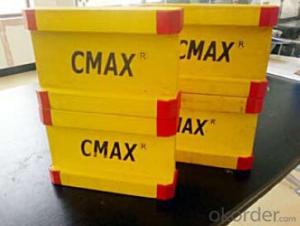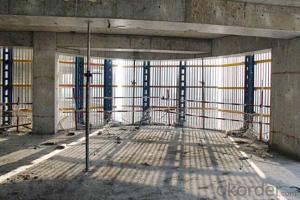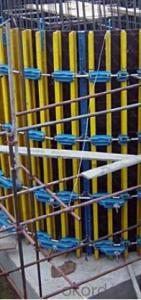Timber Beam for Formwork and Scaffolding system
- Loading Port:
- Tianjin
- Payment Terms:
- TT OR LC
- Min Order Qty:
- 50 m²
- Supply Capability:
- 1000 m²/month
OKorder Service Pledge
OKorder Financial Service
You Might Also Like
Characteristics:
◆ Standardized production lines.
Supply capability: 3000m/day, Lmax = 6600mm.
◆ Finger jointing of the flange and web, the strength of timber beam is highly improved.
Max. shearing force failure load:40KN
◆ Well treated to prevent from water penetration or erosion, so the service life maximally extended.
Normally, CNBM timber beam H20 can be used for 4 to 5 years, the exact using time would depend on maintenance & storage.
◆ Robust caps at the end of the girders protect against damages.


- Q: Can steel formwork be used for both horizontal and vertical concrete placements?
- Yes, steel formwork can be used for both horizontal and vertical concrete placements. Steel formwork provides a strong and durable structure that can withstand the pressure exerted by concrete during pouring and curing processes. It is versatile and can be easily assembled and disassembled, making it suitable for various construction applications.
- Q: What are the different sizes available for steel formwork panels?
- Steel formwork panels are available in various sizes to accommodate different construction needs. The sizes typically range from 1.2 meters to 2.4 meters in width and 1.0 meter to 3.0 meters in height. These dimensions are commonly used in the industry, but manufacturers can also customize the sizes to meet specific project requirements. The selection of the appropriate size depends on factors such as the size of the structure being built, the desired concrete finish, and the ease of transportation and installation. It is important to consult with a professional or supplier to determine the most suitable size for a particular construction project.
- Q: Can steel formwork be used for high-rise buildings?
- Yes, steel formwork can be used for high-rise buildings. Steel formwork is known for its durability, strength, and ability to withstand high concrete pressures. These characteristics make it suitable for constructing tall structures such as high-rise buildings. Steel formwork systems are designed to provide stability and support during the construction process, ensuring that the concrete is properly shaped and cured. Additionally, steel formwork can be easily assembled and disassembled, allowing for efficient construction and adaptability to different project requirements. Overall, steel formwork is a reliable and commonly used solution for high-rise building construction.
- Q: How does steel formwork affect the overall project cost?
- The overall project cost can be significantly affected by steel formwork. Comparatively, steel formwork is generally more expensive than alternatives like wood or aluminum. Nevertheless, there are various factors to consider when assessing the cost-effectiveness of using steel formwork. To begin with, the durability and longevity of steel formwork are well-known. Unlike wood, steel formwork can be reused multiple times, resulting in long-term cost savings. It requires less maintenance and repairs, which reduces the need for frequent replacements. This is particularly advantageous for projects involving repetitive use of formwork. Furthermore, steel formwork provides superior quality and precision in terms of concrete finishing. It offers a smoother surface and accurate dimensions, reducing the necessity for additional finishing work. Consequently, both time and money can be saved during the construction process. Additionally, steel formwork allows for faster construction compared to other types of formwork. It can be assembled and dismantled quickly, leading to faster turnaround times. This can positively impact the overall project schedule and potentially reduce labor costs. Moreover, steel formwork is more resistant to factors such as weather conditions, high pressure, and vibrations. This improves the structural integrity of the concrete, reducing the risk of defects and the need for rework. By minimizing the need for corrective actions, steel formwork can help control project costs. Nevertheless, it is important to note that the cost of steel formwork can vary depending on the size, complexity, and duration of the project. For smaller projects with limited use of formwork, the cost difference between steel and other materials may not be significant. In such cases, alternative formwork options may be more cost-effective. In conclusion, although steel formwork may have a higher upfront cost compared to other materials, its durability, precision, speed, and long-term reusability can result in cost savings throughout the project. It is crucial to carefully evaluate the specific requirements and circumstances of each project to determine the most cost-effective formwork solution.
- Q: What are the different types of formwork corners used in steel formwork systems?
- Various types of formwork corners are utilized in steel formwork systems to create different shapes and angles during the construction process. These corners are specifically designed to offer stability, support, and flexibility when shaping concrete structures. The most common types of formwork corners used in steel formwork systems include the following: 1. External 90-Degree Corner: This particular corner is implemented to form a right angle or 90-degree corner in the formwork. It typically consists of interconnected and reinforced steel plates and angles to provide strength and stability. External 90-degree corners find frequent usage in constructing walls, columns, and beams. 2. Internal 90-Degree Corner: Similar to the external 90-degree corner, the internal 90-degree corner is employed to create a right angle or 90-degree corner in the formwork. However, it is designed to be placed within the formwork, resulting in a smooth finish on the exposed concrete surface. Internal 90-degree corners are commonly employed in walls, columns, and other structures where a clean finish is desired. 3. Adjustable Corner: When there is a requirement for various angles and shapes within the formwork, an adjustable corner comes into play. It comprises adjustable steel plates and angles that can be positioned and securely locked to achieve the desired shape and angle. Adjustable corners are versatile and can be utilized in curved walls, sloping structures, and irregular shapes. 4. Chamfered Corner: A chamfered corner is utilized to create a beveled or chamfered edge on the concrete structure. It typically consists of steel plates and angles that are positioned to form a specific angle or bevel. Chamfered corners are commonly employed in architectural applications to create decorative edges, enhance the structure's appearance, and facilitate a smooth transition between different elements. 5. Rounded Corner: A rounded corner is implemented to create a curved or rounded edge in the concrete structure. It is typically made of steel plates and angles that are bent or shaped to achieve the desired curve or radius. Rounded corners are frequently utilized in architectural applications, such as curved walls, arches, and other curved elements, to create visually appealing and unique designs. These examples represent only a few of the diverse types of formwork corners used in steel formwork systems. The selection of a specific corner type hinges on the desired shape, angle, and finish of the concrete structure being formed. It is crucial to choose the appropriate formwork corner to ensure the integrity and quality of the construction project.
- Q: How much weight can steel formwork support?
- The weight that steel formwork can support depends on various factors such as the thickness and type of steel used, the design and construction of the formwork, and the support system in place. Steel formwork is known for its high strength and durability, which enables it to support heavy loads. Generally, steel formwork can support a significant amount of weight, often ranging from several hundred kilograms to several tonnes. However, it is crucial to ensure that the formwork is properly designed, installed, and supported to safely bear the intended load. It is recommended to consult with structural engineers or follow the manufacturer's guidelines to determine the specific weight capacity of the steel formwork being used.
- Q: What are the different types of steel formwork clamps and connectors?
- Construction projects utilize a variety of steel formwork clamps and connectors, each serving a crucial role in maintaining the stability of the formwork during concrete casting. Here are some commonly used types: 1. Wedge clamps: These clamps effectively secure formwork panels by utilizing a wedge-shaped piece. They are popular for temporary formwork due to their easy installation and removal. 2. Rapid clamps: Designed for quick installation and removal, these clamps have a spring-loaded mechanism that allows for easy adjustment and tightening. They are commonly employed in time-sensitive situations like high-rise construction. 3. Scaffold clamps: Used to connect formwork to scaffolding systems, these clamps ensure a secure and stable connection between the two components during construction. 4. Column clamps: Specifically designed for connecting formwork panels around columns or pillars, these clamps come in various sizes to accommodate different column diameters. They provide a strong and stable connection. 5. Corner clamps: These clamps are employed to connect formwork panels at corners, ensuring a tight fit and preventing any gaps. They offer adjustability, allowing for flexibility in formwork design and easy alignment of panels. 6. Beam clamps: These clamps secure formwork panels to horizontal beams or joists, distributing the load evenly and ensuring overall stability of the formwork system. 7. Pin and wedge connectors: These connectors consist of steel pins and wedges that join formwork panels together. The pins are inserted into pre-drilled holes, and the wedges are hammered in to create a tight connection. They provide a reliable and durable solution. 8. Tie rods and wing nuts: These components work in conjunction with clamps to provide additional support and reinforcement to the formwork system. Tie rods, threaded steel rods, are inserted through the formwork panels and secured with wing nuts, creating a strong and rigid connection. It is important to consider that the specific clamps and connectors used may vary depending on project requirements and the formwork system in use. Consulting a structural engineer or formwork supplier is advisable to determine the most suitable clamps and connectors for a particular construction project.
- Q: What are the different types of coatings used on steel formwork?
- Steel formwork can be protected and its performance enhanced through the use of various types of coatings. These coatings are typically applied to the steel surface to prevent corrosion, increase durability, and improve the overall appearance of the formwork. One commonly used coating for steel formwork is epoxy. Epoxy coatings are recognized for their excellent resistance to chemicals, abrasion, and impact. They create a hard, smooth, and long-lasting surface that can withstand harsh environments and heavy usage. Additionally, epoxy coatings adhere well to the steel surface, ensuring long-term protection against corrosion. Another frequently employed coating for steel formwork is galvanizing. Galvanizing involves applying a zinc layer to the steel surface through hot-dip galvanization. This coating provides exceptional corrosion resistance and helps prolong the formwork's lifespan. Galvanized coatings are particularly suitable for formwork utilized in outdoor or marine environments where exposure to moisture and severe weather conditions is expected. Polyurethane coatings are also utilized on steel formwork to offer high levels of protection and durability. These coatings exhibit outstanding resistance to chemicals, abrasion, and UV radiation, making them ideal for formwork used in construction projects where exposure to harsh elements is common. Furthermore, polyurethane coatings provide a smooth and glossy finish, enhancing the formwork's appearance. Apart from these coatings, there are numerous other types available, such as acrylic coatings, polyester coatings, and powder coatings. Acrylic coatings are known for their strong adhesion and resistance to weather conditions, while polyester coatings offer excellent durability and chemical resistance. On the other hand, powder coatings are applied electrostatically and deliver a highly protective and decorative finish. Ultimately, the choice of coating for steel formwork depends on the specific requirements of the project, including anticipated environmental conditions, desired durability, and aesthetic preferences. It is crucial to carefully consider the properties and advantages of each coating type to ensure that the formwork is adequately protected and performs optimally throughout its lifespan.
- Q: How does steel formwork affect the overall water tightness of a structure?
- Steel formwork does not directly affect the water tightness of a structure as it is used to create the shape and support the concrete during construction. However, the quality of the concrete and the proper installation of seals, joints, and waterproofing measures are crucial factors determining the overall water tightness of the structure.
- Q: What are the characteristics of steel formwork
- The weight is light, the board width is big, the weight of the combined steel formwork can be reduced by 1/4~1/5, and the width of the template plate can be enlarged, and the joint of the template group is reduced.2, reduce the amount of steel, than the combination of steel templates can be reduced by 1/2.
Send your message to us
Timber Beam for Formwork and Scaffolding system
- Loading Port:
- Tianjin
- Payment Terms:
- TT OR LC
- Min Order Qty:
- 50 m²
- Supply Capability:
- 1000 m²/month
OKorder Service Pledge
OKorder Financial Service
Similar products
Hot products
Hot Searches
Related keywords






















